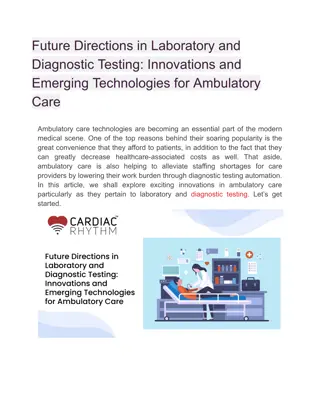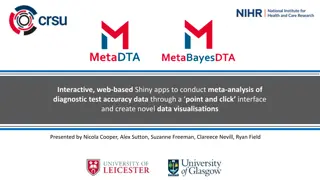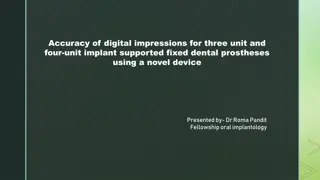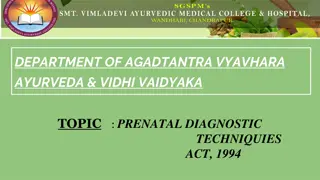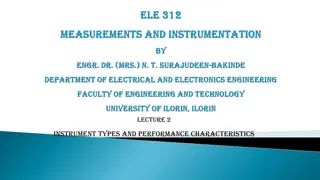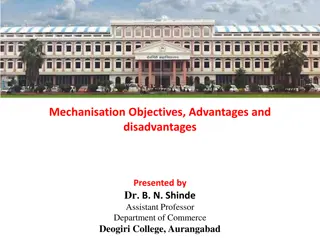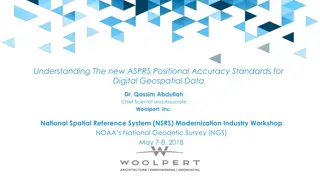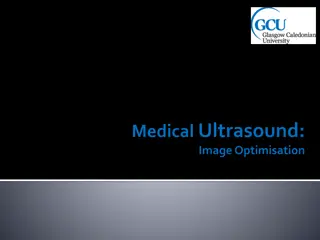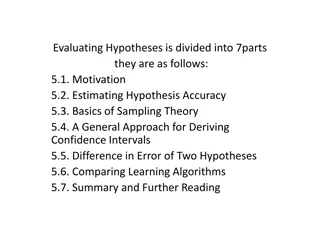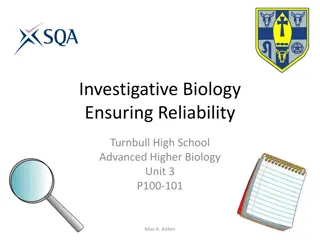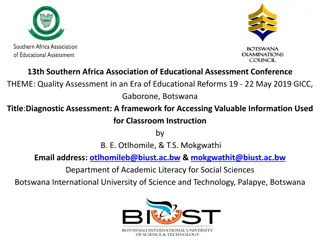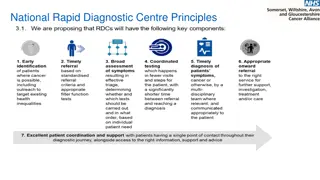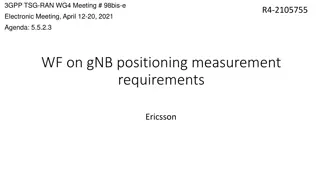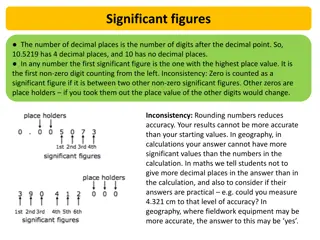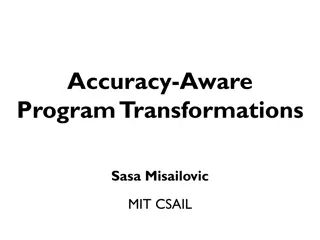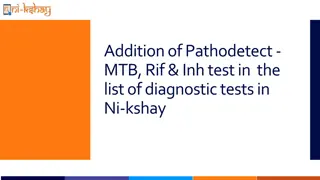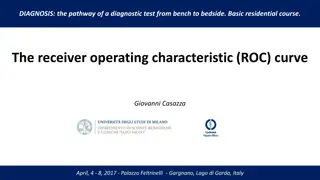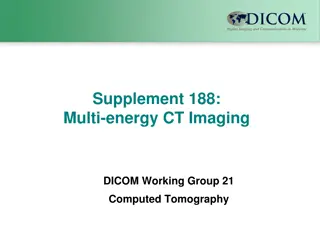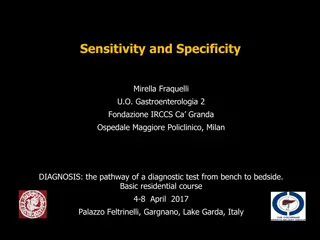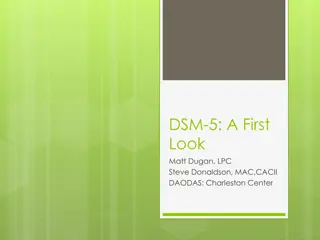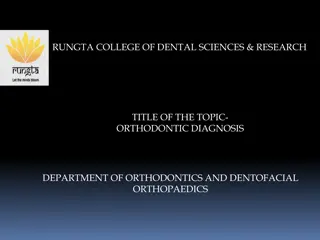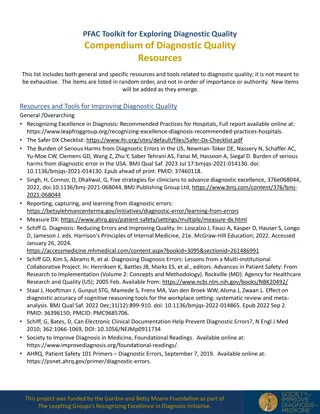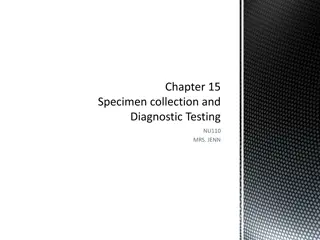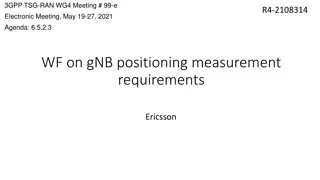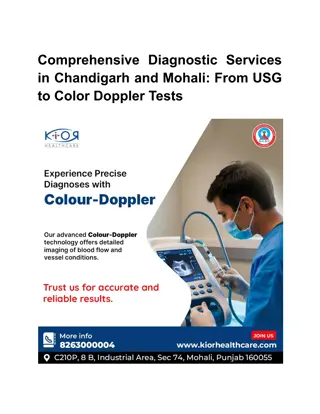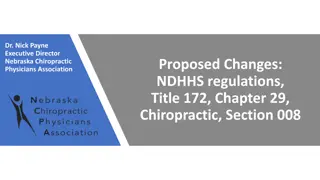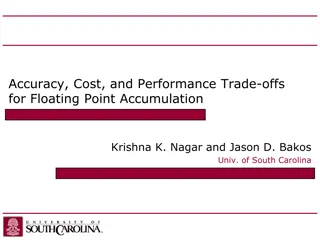Understanding Diagnostic Test Evaluation and Performance
Explore the intricacies of evaluating diagnostic tests, including precision, sensitivity, specificity, and factors influencing test performance. Learn about the purpose of diagnostic tests, examples across various fields, and the types of studies used to assess them.
9 views • 53 slides
Future Directions in Laboratory and Diagnostic Testing_ Innovations and Emerging Technologies for Ambulatory Care
Ambulatory care technologies are becoming an essential part of the modern medical scene. One of the top reasons behind their soaring popularity is the great convenience that they afford to patients, in addition to the fact that they can greatly decrease healthcare-associated costs as well. That asid
12 views • 5 slides
Interactive Web-Based Shiny Apps for Meta-Analysis of Diagnostic Test Accuracy
Explore interactive Shiny apps presented by Nicola Cooper and team for conducting meta-analysis of diagnostic test accuracy data with a point-and-click interface. Find educational primers, principles, and tools to enhance evidence synthesis methods and visualization in healthcare.
2 views • 22 slides
Accuracy of Digital Impressions for Implant-Supported Fixed Dental Prostheses
The study presented by Dr. Roma Pandit explores the accuracy of digital impressions for three-unit and four-unit implant-supported fixed dental prostheses using a novel device. Digital impressions offer advantages over conventional methods, but challenges exist in scanning edentulous areas accuratel
0 views • 13 slides
Understanding the Prenatal Diagnostics Techniques Act of 1994 in India
The Prenatal Diagnostic Techniques Act of 1994 in India aims to curb female foeticide and address the dwindling sex ratio by prohibiting prenatal sex determination. This legislation regulates diagnostic methods, prevents sex selection, and focuses on detecting genetic disorders, metabolic abnormalit
0 views • 15 slides
Understanding Instrument Types and Performance Characteristics
This content discusses different types of instruments, including active and passive, null-type and deflection-type, analog and digital, as well as smart and non-smart instruments. It delves into the static characteristics of instruments such as accuracy, precision, tolerance, linearity, and sensitiv
2 views • 39 slides
Managing State School Aid Application (ASSA) for Increased Accuracy
The process for the Application for State School Aid (ASSA) involves submitting data accurately by reviewing and correcting NJ SMART district enrollment reports. District administrators must ensure the correctness of preloaded data in ASSA for final certification. Important guidelines include resolv
0 views • 33 slides
Understanding Mechanisation in Offices: Objectives, Advantages, and Disadvantages
Mechanisation in office work aims to enhance efficiency, reduce monotony, and improve accuracy by introducing machines and equipment. The objectives of office mechanisation include saving labour and time, ensuring accuracy, and reducing errors. Advantages include quality work output, low operating c
2 views • 18 slides
Exploring Length and Area Concepts in Year 7 Maths
Delve into the world of measurements, accuracy limits, and area calculations in Year 7 Math. Learn about the accuracy of measurements, limits of accuracy, calculating the area of shapes, converting units of area, and investigating the area of triangles. Explore practical examples and understand the
0 views • 20 slides
Evolution of ASPRS Positional Accuracy Standards for Geospatial Data
New technological advancements have prompted the need for updated ASPRS positional accuracy standards for digital geospatial data. Legacy standards from the 1990s are no longer sufficient given the shift towards modern mapping technologies. The new era of mapping involves factors like camera calibra
0 views • 21 slides
Enhancing Reading Fluency in K-3 Literacy: Strategies and Techniques
Educators will explore strategies to improve student fluency in reading, focusing on automaticity, rate, accuracy, and prosody. Reading fluency acts as a bridge between word recognition and text comprehension, with four key components: automaticity, rate, accuracy, and prosody. Techniques such as sp
0 views • 20 slides
Mastering Ultrasound Image Optimization: Enhancing Diagnostic Accuracy
Ultrasound imaging requires applied knowledge and control of technical parameters for optimal image quality and accurate interpretation. Operators must select appropriate transducers, manipulate controls, and customize presets to maximize diagnostic information while following safety principles. Mod
1 views • 15 slides
Diagnostic Test Accuracy Study: Design and Implementation
This content delves into the pathway of a diagnostic test from development to clinical application, focusing on the basic concepts of diagnostic test accuracy, study design, the 2x2 table, and key terminology. It discusses the importance of study design in assessing diagnostic accuracy, including fa
0 views • 16 slides
Understanding Hypothesis Evaluation in Machine Learning
Evaluating hypotheses in machine learning is crucial for assessing accuracy and making informed decisions. This process involves estimating hypothesis accuracy, sampling theory basics, deriving confidence intervals, comparing learning algorithms, and more. Motivated by questions about accuracy estim
0 views • 26 slides
Understanding Non-Parametric ROC Analysis in Diagnostic Testing
Non-parametric ROC analysis is a crucial method in diagnostic testing to determine the performance of binary classification tests in distinguishing between diseased and healthy subjects. This analysis involves evaluating sensitivity, specificity, positive predictive value, and negative predictive va
10 views • 22 slides
Understanding Precision, Accuracy, and Reliability in Investigative Biology
Precision, accuracy, and replicates play crucial roles in ensuring reliable results in investigative biology experiments. Precision refers to the closeness of measurements, accuracy to how close they are to the actual value. Replicates involve multiple measurements within the same experiment or repe
0 views • 6 slides
Enhancing Educational Assessment Through Diagnostic Techniques
Diagnostic Assessment (DA) is a valuable technique that provides detailed information about students' knowledge and skills, supporting teachers in identifying strengths and weaknesses for tailored instruction. This approach offers a more nuanced understanding than traditional assessments, contributi
0 views • 20 slides
Prostate Rapid Diagnostic Service Transformation Overview
The document outlines the transformation of the Prostate Rapid Diagnostic Service (RDS), detailing plans, due diligence requirements, implementation timelines, and good practices such as virtual telephone triage systems and use of MRI before biopsies. It emphasizes the implementation of Rapid Diagno
4 views • 8 slides
Diagnostic Specialty Antibodies Market, Diagnostic Antibody, Infectious Disease
Diagnostic Specialty Antibodies Market by Type (Primary, Secondary), Clonality (Monoclonal, Polyclonal), Technique (WB, Rapid Test, IHC, IP), Conjugate, and Application (Dengue, Malaria, Hepatitis, HIV, E. coli , Tuberculosis, Pneumonia, Cancer)- For
0 views • 3 slides
gNB Positioning Measurement Requirements Discussion at 3GPP TSG-RAN WG4 Meeting
Discussion at the 3GPP TSG-RAN WG4 meeting #98bis-e focused on gNB positioning measurement requirements, including beam sweeping, gNB accuracy requirements, samples for gNB accuracy, RoAoA side conditions, and SRS-RSRP measurement accuracy requirements. The meeting addressed various candidate option
1 views • 14 slides
Applications of Radioisotopes in Nuclear Medicine
Nuclear medicine utilizes radioisotopes to provide crucial diagnostic information about the functioning of specific organs and to treat various conditions. Diagnostic techniques in nuclear medicine involve using radioactive tracers that emit gamma rays from within the body. Positron Emission Tomogra
0 views • 19 slides
SWAG Cancer Alliance Rapid Diagnostic Services Implementation Plan
The SWAG Cancer Alliance aims to develop Rapid Diagnostic Services for patients with non-specific symptoms within Primary Care Networks. By 2028, the goal is to diagnose 75% of cancers at Stage 1 & 2, emphasizing personalized, timely diagnoses integrated with existing diagnostic provision. The appro
0 views • 8 slides
Learning from Fictional Detectives for Better Diagnostic Skills
Explore the application of lessons from fictional detectives like Sherlock Holmes to enhance diagnostic processes in medicine. Delve into problem representation, observation, deduction, and clinical reasoning strategies to improve diagnostic accuracy and patient care.
0 views • 68 slides
Understanding Significant Figures in Mathematics and Science
Significant figures play a crucial role in maintaining accuracy and precision in mathematical and scientific calculations. They help in determining the level of accuracy of measurements and calculations by focusing on the number of significant digits and decimal places. Rounding rules are essential
0 views • 6 slides
Accuracy-Aware Program Transformations for Energy-Efficient Computing
Explore the concept of accuracy-aware program transformations led by Sasa Misailovic and collaborators at MIT CSAIL. The research focuses on trading accuracy for energy and performance, harnessing approximate computing, and applying automated transformations in program optimization. Discover how to
0 views • 20 slides
Enhancing Diagnostic Tests with Pathodetect in Ni-kshay Module
A new test type, Pathodetect-MTB, Rif & Inh, has been introduced for tuberculosis diagnosis in Pathodetect laboratories. This test has been added to the diagnostic tests list in the Ni-kshay module, enabling seamless reporting in TB diagnostic facilities. The process of adding this test, including s
0 views • 10 slides
Understanding Diagnostic Test Accuracy: A Practical Overview
Navigate through the pathway of diagnostic test development, implementation, and evaluation from bench to bedside. Explore the Receiver Operating Characteristic (ROC) curve, the impact of cut-off variations on sensitivity and specificity, and the practical application of continuous measurement in di
0 views • 32 slides
Innovations in Multi-energy CT Imaging for Enhanced Diagnostic Capabilities
Cutting-edge Multi-energy CT (MECT) imaging brings a paradigm shift by utilizing varied X-ray beam energies for tissue differentiation and quantification. The rationales, techniques, and objectives are outlined for seamless integration into existing systems, paving the way for improved diagnostic ac
0 views • 15 slides
Diagnostic Approaches in Hematologic Disorders: A Comprehensive Overview
Explore the diagnostic considerations for multiple myeloma, monoclonal gammopathy of undetermined significance (MGUS), and related conditions, including indications for serum protein electrophoresis (SPEP) and free light chain (FLC) testing. Learn when not to order SPEP and FLC, and consider various
0 views • 24 slides
Understanding Sensitivity and Specificity in Diagnostic Testing
Sensitivity and specificity are crucial measures in evaluating the accuracy of diagnostic tests. Sensitivity reflects the test's ability to correctly identify individuals with a particular condition, while specificity indicates its ability to correctly identify those without the condition. This comp
0 views • 21 slides
Understanding DSM-5: A Clinician's Perspective on Revisions and Changes
DSM-5, authored by Matt Dugan, LPC, and Steve Donaldson, MAC, CACII, provides a comprehensive look at the revisions and changes from DSM-IV-TR. It discusses the importance of evolving diagnostic systems to capture clinical experiences effectively. The book emphasizes the need for a dimensional appro
0 views • 46 slides
Orthodontic Diagnosis: Essential Tools and Techniques
This detailed guide covers essential diagnostic aids for orthodontic diagnosis, including case history, general examination, intraoral examination, supplemental diagnostic aids, orthodontic study models, diagnostic setups, facial photographs, electromyography, radiographs, recent advances, and more.
0 views • 39 slides
Utilizing Different Samples for Diagnostic Testing in Medicine
The practice of diagnostic testing in medicine goes beyond blood and stool samples. Gathering urine samples, for example, allows healthcare providers to assess various health aspects, such as kidney function, urinary tract infections, diabetes, and more. By examining the color, clarity, odor, densit
0 views • 21 slides
Toolkit for Exploring Diagnostic Quality Resources
A compendium of resources and tools for improving diagnostic quality, covering general and specific aspects. It includes recommendations for hospitals, checklists, research on diagnostic errors, strategies for clinicians, cognitive reasoning tools, readings on diagnostic errors, and more. The list i
0 views • 5 slides
Guidelines for Safe and Efficient Diagnostic Testing Procedures
This content provides detailed guidelines and procedures for specimen collection and diagnostic testing in healthcare settings, covering aspects such as patient assessment, specimen labeling, completing diagnostic requisition forms, and specific procedures like amniocentesis, arteriography, barium e
0 views • 21 slides
3GPP TSG-RAN WG4 Meeting #99-e Electronic Meeting Agenda
The 3GPP TSG-RAN WG4 meeting #99-e electronic meeting held on May 19-27, 2021 discussed gNB positioning measurement requirements, SRS-RSRP accuracy requirements, beam sweeping during gNB measurement, impact of SRS/IoT on accuracy, RF margin for SRS-RSRP, and gNB Tx accuracy requirements. The meeting
0 views • 9 slides
Comprehensive Diagnostic Services in Chandigarh and Mohali_ From USG to Color Doppler Tests
In modern healthcare, diagnostic services are essential for early detection, monitoring, and effective treatment of various health conditions. For residents of Chandigarh and Mohali, access to high-quality diagnostic facilities has never been easier.
1 views • 4 slides
SNAP Client Integrity and Payment Accuracy Highlights
The SNAP (Supplemental Nutrition Assistance Program) conference in Paris on March 14, 2012, covered topics such as client integrity and payment accuracy. The focus was on combating recipient fraud and ensuring accurate benefit distribution. Troubling activities like the sale of EBT cards and unexpla
0 views • 23 slides
Impact of Court Decision on Chiropractic Diagnostic Testing Regulations
The court case of Yagodinski v. Sutton in Nebraska involving expert testimony on traumatic brain injuries by chiropractors has raised questions about the scope of diagnostic testing allowed for chiropractic care. The court ruled that specialized tests used by chiropractors may not be admissible in c
0 views • 8 slides
Trade-offs in Floating Point Accumulation: Balancing Accuracy, Cost, and Performance
When designing floating point accumulation systems, achieving high throughput and accuracy presents a challenging trade-off. Inconsistent accuracy due to data dependencies can lead to significant errors in results. Strategies such as compensated summation or using extended precision adders can help
0 views • 11 slides

